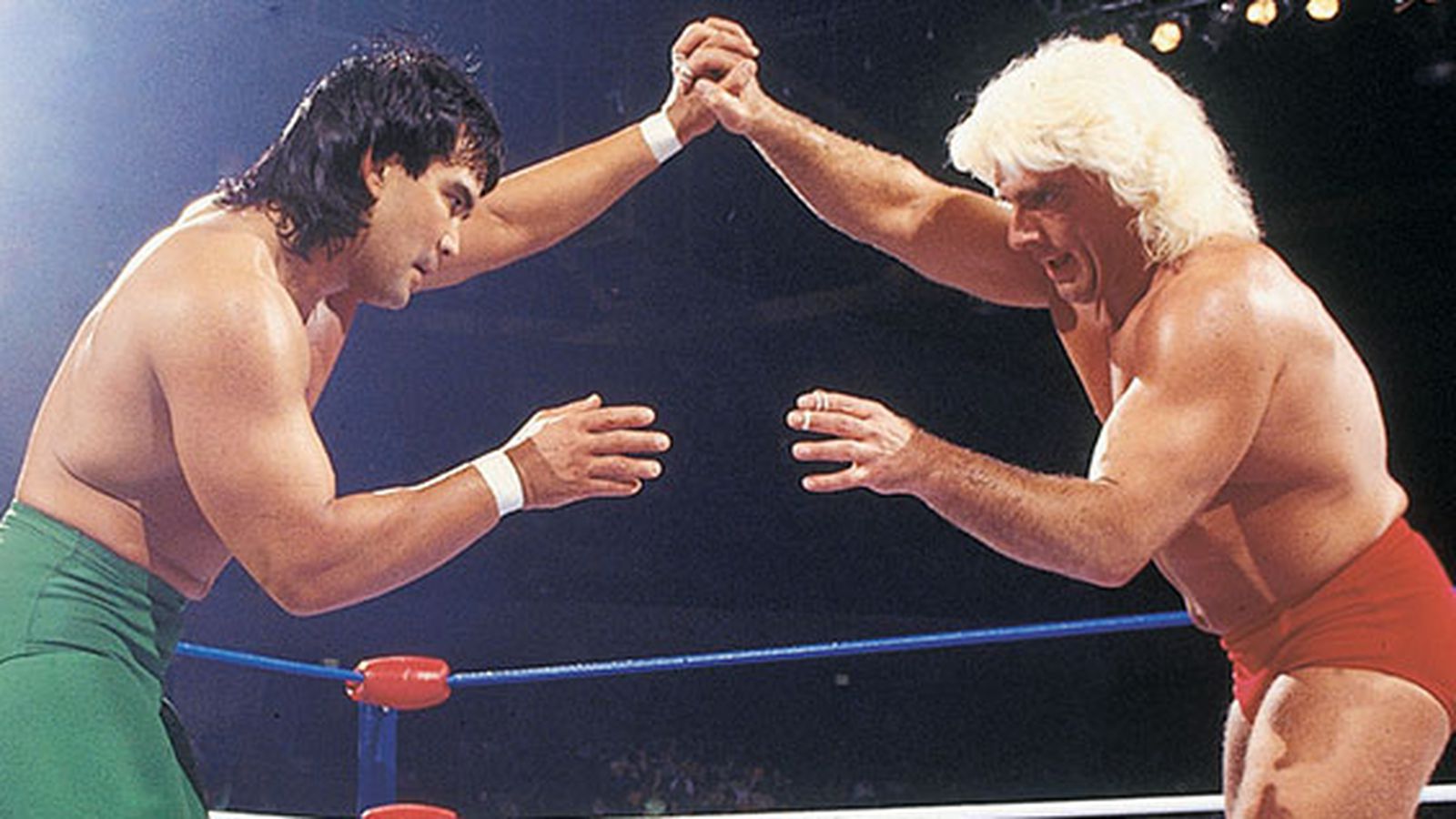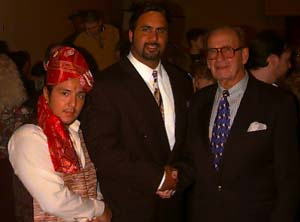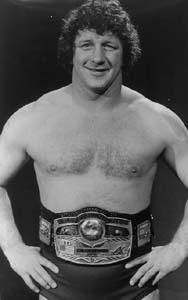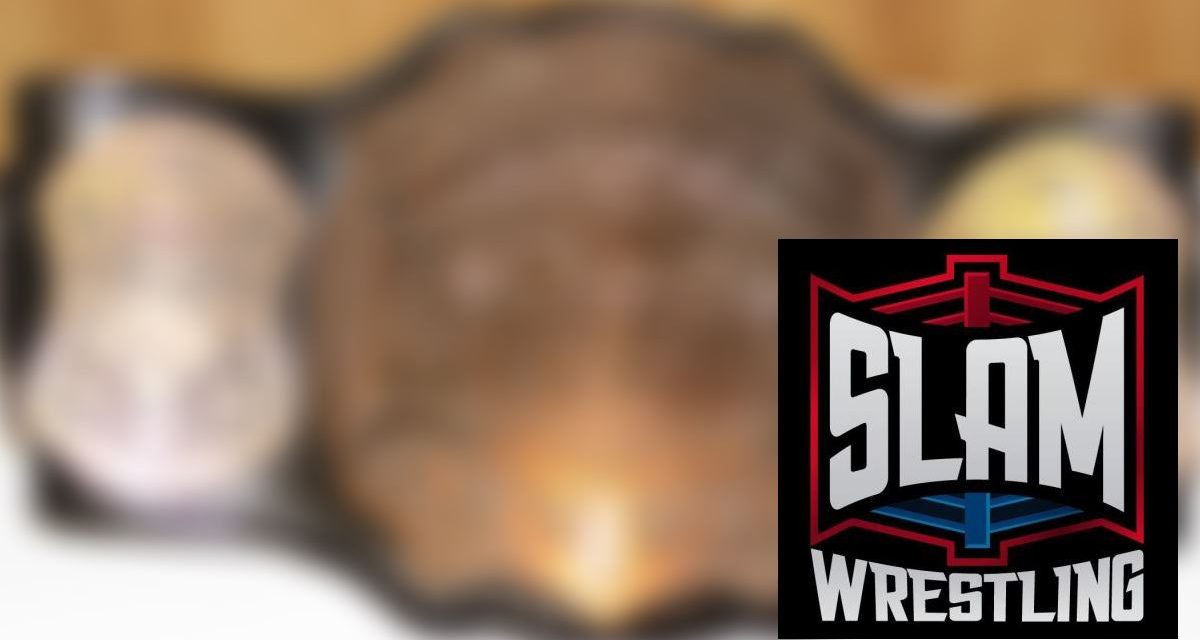It was 1948. War-torn South Korea dominated headlines. U.S. President Harry Truman had ordered the withdrawl of American troops from Korea. The Asian theatre was in turmoil. Who could have guessed that at the same time, the fate of the wrestling world was being inextricably changed forever in a hotel in Waterloo, Iowa?
On July 14 1948, St Louis promoter Sam Muchnick met with five other promoters in an effort to consolidate power. The promoters, in charge of six of the biggest territories in the Midwest, had reached an agreement. They would work together, exchanging talent and look out for one another against competing promoters who would encroach their fiefdom and dare to run opposition to them. They would control the destiny of the sport, essentially blacklisting any wrestler who didn’t tow the line and abide by a promoter’s wishes. They would promote their shows under the same banner, and recognize one world champion.

Ricky Steamboat faces Ric Flair.
And with that agreement, the National Wrestling Alliance was born.
At its peak, the NWA boasted 38 members, with offices across the U.S., Canada, Japan, Mexico and the South Pacific. As the most powerful and influential governing body in wrestling history, the NWA changed the way wrestling was run. This conglomerate of promoters put a strangle hold on the business, crushing rival offices. By securing the best wrestling talent in the world, the NWA quickly became the archetypal wrestling banner in the world.
The shining symbol of the NWA was the World champion. The NWA set the standard of excellence and athleticism in pro wrestling. It was a standard built on the backs of the NWA World champions.
Men like Lou Thesz, Buddy Rogers, Gene Kiniski, The Funk Brothers, Jack Brisco, Harley Race, and Ric Flair helped to build the NWA World Heavyweight title into the most prestigious title in wrestling. Wrestling over 300 times a year, these men travelled the globe, taxing their bodies by touring every NWA territory and competing against that office’s top competitor.
Each one left an indelible mark on the title. Each one left a distinctive legacy. Each one was special in their own way. Invariably, comparisons are drawn between them all. Debates ensue among wrestling historians. And the question that always gets asked is who was the greatest NWA World Champion of all time?

Babu, Tiger Ali Singh and Lou Thesz at the NWA 50th Anniversary. — Photo by Greg Oliver
This past summer, SLAM! Wrestling conducted exhaustive interviews with some of the top wrestling experts. Ex-wrestlers, promoters, journalists and wrestling historians were contacted and asked to categorize the greatest NWA champ in three categories: 1) in ring talent, 2) influence on the NWA, and 3) drawing ability as champion. Each respondent weighed the rich history of the NWA World title in their minds and, almost universally, recognized one man as the greatest NWA World Champion of all time: ‘Nature Boy’ Ric Flair.
“He could do almost anything he wanted in the ring,” said Dave Meltzer, editor of the Wrestling Observer Newsletter. “He had that drive to be the best, more than any wrestler I’ve ever seen.”
Unlike champions of today who are promoted to look invincible and unbeatable, the NWA World Champion’s job was to make his opponent look credible. He had to make it look like he could lose the title at any given moment before eventually putting him away. And he had to carry the most hapless wrestlers and portray them as superstars.
It’s this last point that for many made Flair the best NWA Champ.
“Flair took some total stiffs and had great matches with them night after night,” explained Meltzer. “More than anybody else, Flair was able to sell that he was within an eyelash of losing the title. He made the other guy look great.”
“Flair was one of the most versatile performers in the history of the business,” opined Bill Apter, editor of World of Wrestling (WOW) magazine. “No matter who the NWA fed to him, he was able to adjust his style and have a classic match with any opponent.”
Longevity was another deciding factor for many in picking Flair.
“I would pick Flair because of his total domination of the belt during the 80s,” said Bob Ryder, owner of 1wrestling.com. “If you add up the time he was without the belt during the decade, the total days add up to less than one year.”
Flair also had drawing power and could ignite a territory with one of his legendary title defenses.
“Flair was the one who singlehandedly pulled Toronto wrestling (Frank Tunney’s office) back to popularity in the mid-’70s,” explained Gary Will, author of Wrestling Title Histories. “Every skill you had to have in wrestling, he had it to the highest degree.”
“Flair put the total wrestling package together,” concurred Jeff Marek of Live Audio Wrestling on FAN590. “He was a great performer and was on top for so long.”
Lou Thesz finished second in our informal poll, and was recognized as the most influential NWA Champion. For many, the Michigan native was the archetypal wrestler of the ages.
“Lou Thesz carried the NWA from the ’40s right through the early ’60s,” stated current NWA President Howard Brody. “The NWA was built on his shoulders.”
“Thesz shaped the early history of the NWA,” according to Meltzer. “He shaped the idea that the title had to be held by someone of credibility.”
“Thesz had a lasting impact on pro wrestling worldwide,” explained wrestling historian Sheldon Goldberg. “The man was a wrestling machine and defended the title all over the world and was the first World Champion to defend the title in Japan after World War II.”
Thesz was a legitimate pro wrestler and a had a reputation of being a tough guy and someone who could take care of himself. Because of this, he was rarely double-crossed in thge ring.
“You didn’t mess with Thesz,” said Dave Scherer of 1wrestling.com. “People knew that if they ever tried to cross him in the ring, they would most probably fail.”
Dory Funk Jr. reigned as NWA champ from 1969-1973 and finished third in our poll. Funk was chosen as the best drawing NWA World champ by our experts.
Michel DuBois had title matches with seven different NWA World champions, from Thesz to Flair, and rates Dory as the greatest.
“To me, my idol who stood above everyone else, was Dory Funk Jr,” offered Dubois, who also wrestled as Alexis Smirnoff.
“Dory Funk Jr logged more miles than any other champion and wrestled a different style almost every night.”
Dory’s younger brother Terry also received some consideration.

Terry Funk with the NWA World Title.
“It was pretty hard to take it away from Terry Funk,” said former wrestler Yvon Cormier, who competed as The Beast. Cormier wrestled seven different champions and remembers his matches with Terry Funk the most.
“I wrestled him three times to 90-minute draws. I remember one night in Dallas, the doctor weighed me in at 257 (before the match), when I came out (of the ring) I weighed 244!”
Jack Brisco was a collegiate wrestling champion and was generally regarded as the top technician by our experts.
“During my career I had around 300 matches with Jack Brisco and everywhere we went it was a sellout,” stated former NWA World Champ Dory Funk Jr. “From St. Louis to Japan, Florida and Texas, it was a natural sellout.”
“(One champ) I might rate ahead of Dory Funk actually would be the late Pat O’Connor,” opined Canadian wrestling legend Leo Burke. “He was everything that you’d want to see in a wrestler.”
In a bit of a surprise Harley Race, Gene Kiniski and Buddy Rogers did not fare well in our polling. Nonetheless, their tenures as NWA World Champs were distinguished.
“He was a master showman,” said Bill Apter of the original Nature Boy. “No NWA champion ever had the polish that Buddy Rogers had.”
Gary Will agrees, stating “he had the most complete package of wrestling skills in history.”
“Gene Kiniski was a great worker,” said Meltzer. “Kiniski had a lot of respect from the wrestlers.”
“Harley Race was a solid champion,” stated Sheldon Goldberg. “(He was) more of a brawler than a wrestler. He did the title proud.”
What made the NWA World title so special was what it symbolized: the best pro wrestling had to offer. You couldn’t hold the title unless you were one of the elite workers in the business. Looking back, the title reigns of Tommy Rich, Giant Baba and Kerry Von Erich notwithstanding, that was the case.
From 1948 to its death in the late ’80s and to its resurrection in the ’90s, the NWA World champion elevated the World title to another level and was the flag bearer of the alliance at their time. Perhaps, it seems unfair to compare the champions. After all, they all competed in different times, against different opponents when the standards of what defined a great wrestler differed. To pick just one seems unfair.
And it is. But there can be no debate that men like Ric Flair, Lou Thesz and Dory Funk Jr helped build the NWA World title into what it was: the most prized trophy in pro wrestling history.
— with files from Greg Oliver
| Expert | Greatest in-ring champ | Most influential champ | Greatest drawing champ |
| Dave Meltzer – Wrestling Observor Newsletter | Ric Flair | Lou Thesz | Dory Funk Jr |
| Dory Funk Jr – former NWA World Champ | Jack Brisco | – | Jack Brisco |
| Howard Brody – Current NWA President | Lou Thesz | Lou Thesz | Dory Funk Jr |
| Bill Apter – WOW Magazine Editor | Dory Jr/Brisco | Lou Thesz | Ric Flair |
| Bob Ryder – Owner, 1wrestling.com | Ric Flair | Lou Thesz | Dory Funk Jr |
| Sheldon Goldberg – promoter, historian | Lou Thesz | Lou Thesz | Dory Funk Jr |
| Gary Will – author, Wrestling Titles Histories | Ric Flair | Lou Thesz | Dory Funk Jr |
| Jeff Marek – Live Audio Wrestling | Ric Flair | Ric Flair | Ric Flair |
| Dave Scherer – 1Wrestling.com | Ric Flair | Lou Thesz | Dory Funk Jr |
| Barry Owen – former NWA promoter | Ric Flair | Ric Flair | Ric Flair |

